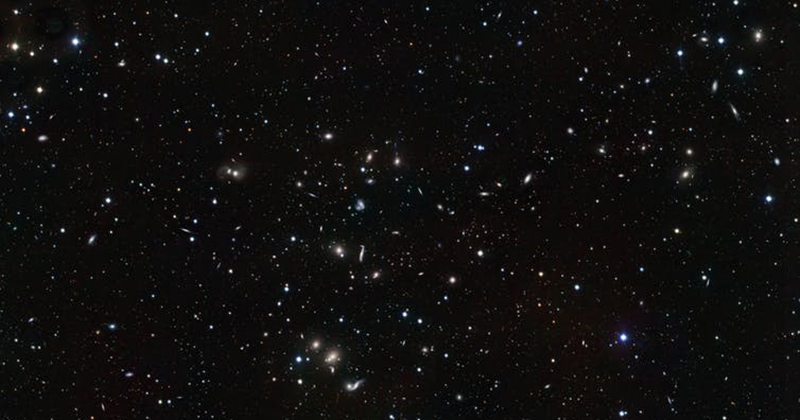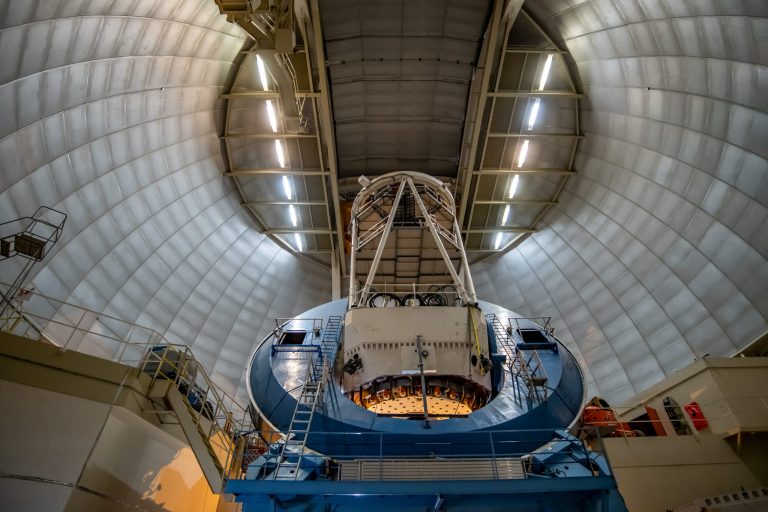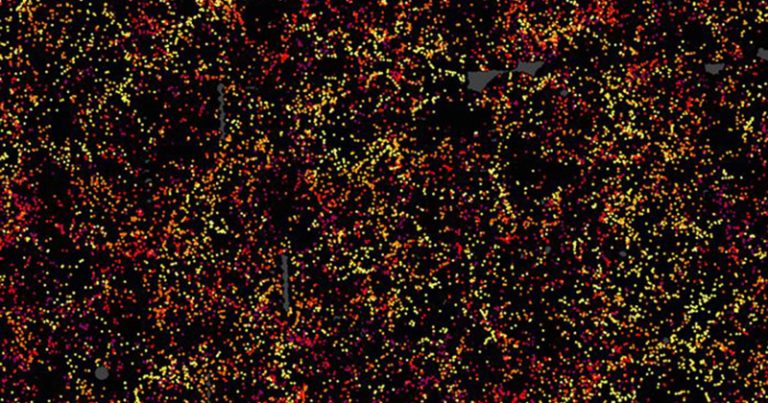
“Ghosts” that, despite being everywhere, almost do not interact with the matter and cross even our bodies, to the billions. This mysterious particle is the neutrino, which has just had an important feature revealed. The lightest neutrino mass was estimated to be at least 6 million times lighter than the mass of an electron. The study led by University College London (UCL) was conducted in collaboration with Institut d’astrophysique de Paris, Universidade Federal do Rio de Janeiro (Federal University of Rio de Janeiro – UFRJ) and Universidade de São Paulo (University of São Paulo – USP), and published in the journal Physical Review Letters — besides being highlighted by journal Nature.
“We know how neutrino affects the distribution of matter in the universe,” says Arthur Loureiro, a researcher at UCL and first author of the article, explaining how Galaxy data could be included among the sources of the mathematical model that revealed this information about the particle mass.
And why is this knowledge going to make such a difference to physicists? Understanding better the neutrinos and the processes by which they obtain their masses can help answer important questions about our universe. This includes how galaxies are distributed, why the universe is expanding rapidly and of what is made the dark matter, which is still an unknown nuisance of science — the neutrino itself has already been considered as the particle of dark matter.
In addition, understanding how the mass of neutrinos can be estimated is of relevant importance for developing telescopes, such as the Dark Energy Spectroscopic Instrument (DESI) and the Euclid. DESI will study the large-scale structure of the universe and what it contains of dark matter and dark energy with high precision. Euclid is a telescope that is being built by the European Space Agency (ESA) to map the geometry of the dark universe and the evolution of cosmic structures.

Neapolitan ice cream
In the world of subatomic particles, as in the case of neutrino, the matter is governed by the laws of quantum mechanics — and not classical. And these laws are not always intuitive. A particle, for example, can convert itself into something else, or acquire a certain mass, and return to the initial state quickly, and that is why statistics is one of the most used methods by those who study quantum physics. Talk about probabilities.
Neutrinos appear in nature in three different “flavors”: Electron neutrino (those that are produced in the sun); The muon neutrino and the tau neutrino. Each of them is composed by a mixture of three different neutrinos masses. Only the difference between these masses was known until then, with little information about the lighter mass of the kind.
“We know very little about neutrinos. What we do know is that when they move, there is a probability of changing between one of the three versions. And that can only happen if at least two of its masses are greater than zero,” says Arthur Loureiro, who is an alumnus of the Instituto de Física (Institute of Physics – IF) of USP.
He uses as an analogy the Neapolitan ice cream: when catching a spoonful, we have the three flavors always present, but in different proportions. “This change in proportions and flavor — and as a consequence, the strange behavior of these particles — can only be explained by neutrinos having mass,” explains Loureiro, remembering that the concept of neutrinos having a mass is relatively new, proven by a discovery of 1998, and it has not yet been possible to incorporate this data into the Standard Model, which so far is the most well-established theory on the structure of matters and the forces that interact with it.

But between knowing that neutrinos have mass and accurately determine their value, there is a wide path. What the study did, in an unprecedented way, was to determine an upper limit for the lighter neutrino mass. “When we can measure the lighter neutrino mass, we will be able to fill some gaps in the theories that try to explain the origin of the neutrino mass,” explains Loureiro.
We will also be closer to understanding two phenomena about which we know virtually nothing: dark matter and dark energy. Both are known only by their effects. The dark matter must exist because only the mass of the visible matter would not be enough to keep the galaxies together as they are. The dark energy must be the cause of the universe accelerated expansion, a phenomenon that has been observed, but not explained. The Big Bang explains the expansion — but if there was no energy acting, this expansion would be slowing down, by inertia.
It is noteworthy that although the neutrino has already been considered a candidate for dark matter, this hypothesis has already been dismissed. “A little bit of what we once thought was dark matter, today we know that are neutrinos, but very little,” says the researcher. But it is still called by some as hot dark matter for, when it arises, from the decay of other particles in the atom, it comes out at very high speed, close to that of light.
Anyway, “we still need to take into account how much of the universe is composed of neutrinos to accurately know how much is dark matter,” explains the scientist. Moreover, he says that the theory that eventually will come to explain the neutrinos mass should also help us to understand what is dark matter, since both are extensions of the Standard Model of particle physics.

Big Data
To win this first challenge, which was to calculate the upper limit of the mass, the team of researchers used an innovative approach using public data collected by scientists from the fields of cosmology and particle physics. Which includes data from more than 1 million galaxies of the Baryon Oscillation Spectroscopic Survey (BOSS) to measure the expansion rate of the universe and measurements of experiments such as particle accelerators.
“Neutrinos are extremely abundant, but very small and elusive, so we needed any piece of knowledge available to estimate their masses,” says Loureiro, explaining that information was used from a variety of experiments and sources, such as space and terrestrial telescopes observing the first light of the universe (the cosmic microwave background), supernovas, the largest 3D map of universe galaxies, particle accelerators and nuclear reactors, among others.
The information was used together to prepare a framework of analyses in which the mass of neutrinos can be computed individually using a simple mathematical model. “The team used the UCL supercomputer, Grace, to calculate that the largest possible mass for the lightest neutrino should be less than 0.086 eV (with 95% confidence), which is equivalent to 1.5 × 10-37 Kg. It was also estimated that the mass of the three neutrino species together should have an upper limit of 0.26 eV (also with 95% confidence),” he describes.
“We used more than half a million hours of processing to analyze the data; This would be equivalent to 60 years in a single processor. This project raised the limits for Big Data analysis in cosmology,” says Andreu Cuceu, PhD student at UCL and second author of the article. They also emphasize that the method can be applied to other major intriguing questions in cosmology and particle physics.
The professor Ofer Lahav (UCL), co-author of the study and President of the British consortia of the Dark Energy Survey and DESI, says that “it is impressive how the distribution of galaxies on immense scales can tell us about the lighter neutrino mass” and that this is a result of fundamental importance for physics. “This new study demonstrates that we are on the way to really measure the mass of neutrinos using the next generation of large surveys of spectroscopic galaxies such as DESI, Euclid and others,” he concludes.
The article Upper Bound of Neutrino Masses from Combined Cosmological Observations and Particle Physics Experiments may be accessed at this link.
The study was attended by the researcher of the Instituto de Astronomia, Geofísica e Ciências Atmosféricas (Institute of Astronomy, Geophysics and Atmospheric Sciences – IAG) of USP Henrique Xavier.
The research was funded by the Conselho Nacional para o Desenvolvimento Científico e Tecnológico (CNPq) by scholarships of the Science without Borders, by the Royal Astronomy Society, The Science and Technology Facilities Council (STFC), Royal Society, and the European Research Council.
More information: E-mail arthur.loureiro.14@ucl.ac.uk
By Luiza Caires – jornal.usp.br
